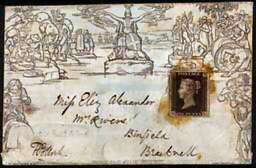
 |
| Home |
|
Alpaca and Llama Stamps Around Our World(and...how postage stamps came to be)
The use of stamps and the customs we follow today began in Victorian Britain with Rowland Hill's postal reforms of 1840. Prior to that time, envelopes did not exist, stamps had not yet been invented and in fact, homes had no house numbers. Messages were written on sheets of paper, folded, then secured with a wax seal and mailed. The cost of delivery was based on the number of sheets of paper contained in the mailing. In 1840, town populations were small enough that those responsible for getting the mail to the proper recipient not only knew most residents by name but also exactly where they lived. Roads were often given names by the people who built them and you could personally choose a number - any number - to designate your private residence. When people moved, they were allowed to take their "house " number with them. By the 1850's, however, things were getting mighty confusing. London's population had grown to more than 2.4 million. There were now 62 streets in London alone named "George Street"' and because one could take their house number with them and reuse it, there were often several of the same numbers on the same street - or same named streets - for different residences. Confusion Leads To StandardsTo work on this ever-growing dilemma, the "Committee of the Board of Works on Street Nomenclature" was established in the early 1850's. This committee set the standards for house numbering which continues to see wide use today. Among them were that odd numbers would be on the right side of the street with even numbers on the left. The lowest numbers began closest to St. Paul's Cathedral with the numbers becoming larger as one moved further out from the Cathedral. First Envelope and Stamps Issued The
elaborately designed Mulready
Envelope The
elaborately designed Mulready
Envelope
At this same time, Rowland Hill was busy promoting the Mulready (first envelope named after designer William Mulready) along with the idea of a stamp. As populations grew, so did the amount of deliverable correspondence. With the advent of the envelope, it became unreasonable to continue to count the number of sheets of paper included in each individual correspondence in order to determine each individual mailing cost. Enter… the stamp. It was first thought to place a stamp on the back of the envelope where the wax seal had appeared on correspondence for so many years prior. Though tradition would favor that placement, it is presumed predominantly right-handed postal clerks finally pushed to uniformly place the postage stamp on the front of the envelope in the upper right corner for a quick and easy obliteration. The process of cancellation could and would proceed much more quickly if every stamp were placed in the same spot on every envelope. |
|
The first postage stamps were issued in England in 1840 with the Penny Blacks and Twopenny Blues. Topical StampsToday there are hundreds of thousands of stamps issued in countries around the globe. Some smaller countries will regularly issue stamps not officially recognized nor used as legal postage. They are created specifically for collectors. It is a true and somewhat significant source of revenue. Stamps can mean big business when the subject matter is in demand by collectors. Such has been the case with stamps depicting Elvis, the Beatles, Princess Diana or President Kennedy. There is a Topical Stamp Society for those interested in collecting stamps of a particular subject or theme such as trains, trees, ships, dogs, birds, Scouts, music, aircraft or bees. The Topical Society maintains an updated listing of stamps issued around the world each year under a very wide variety of topics. Alpacas and llamas, however, are not one of them. |
||
As a llama owner and stamp collector as a young child, I was curious and began to search catalog after catalog for stamps depicting lamas (llama, alpaca, guanaco and vicuna.) It was a most difficult and very time-consuming endeavor. There are no special listings for lamas and stamp dealers/shops across the nation were baffled by my inquiries. Undaunted, I persisted in my search until finally connecting with philatelic (stamp) dealers in South America. Today I have put together one of the worlds largest lama stamp collections and continue to donate a number of framed groupings for llama and alpaca association fundraising events. The collections are well received and have stimulated some very active bidding. |
||
|
||
Peru pictures the llama on their country Coat of Arms and has issued the largest variety of lama stamps.
Issued
by Chuvashia, Russia |
||
Historically, stamps are issued to honor significant events, inventions, art, culture and individuals for their contributions to our world. The United States has a special committee to review ideas and suggestions for stamp issues. There is no doubt that lamas have played a most important historical role and continue to remain significant members of South American culture. Today, the images of alpacas and llamas can be found on postage stamps around the world. It certainly seems fitting that they are so highly honored in this way. |
||
 |
©™ 2013 Cathy Spalding Gentle Spirit Llamas |
Customer Service Privacy Policy |
Terms
and Conditions |
Contact Webmaster Craig Spalding |
 |